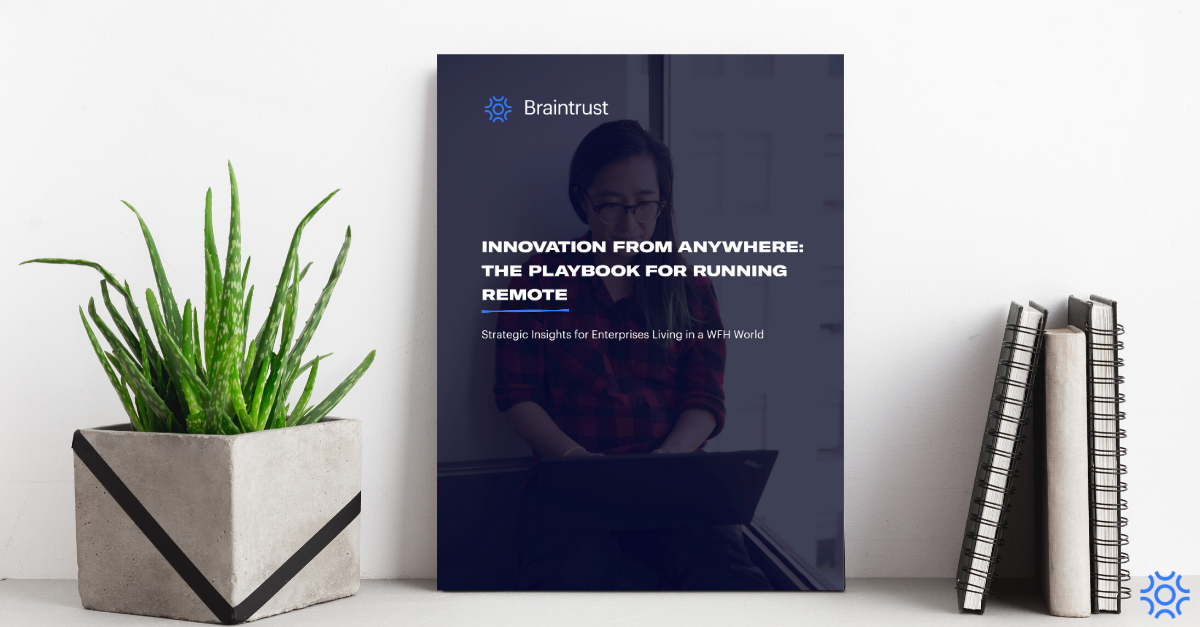Now that many enterprises have established high-level guidelines for remote employees, it's time to shift your attention to more advanced topics like company culture, team alignment and how to properly onboard virtual hires.
We've spent the past several weeks capturing insights from some the top freelancers and core team members across our 100%-remote organization, plus recommendations from leaders at Facebook and GitLab.
We've published those findings in a new eBook, Innovation From Anywhere: The Playbook for Running Remote.
This eBook can help enterprise leaders introduce meaningful changes that enable remote teams to be more productive, more connected and to drive growth and innovation amid difficult transitions and circumstances.
Below you'll find a quick excerpt from the book's introduction, and a list of the chapters and key concepts discussed throughout the piece.
"As individuals, organizations and governments continue to adapt in response to COVID-19, the traditional stigmas and barriers associated with working virtually have all but vanished. The closing of non-essential offices, increasing travel restrictions and shelter-in-place mandates have forced a staggering number of businesses to rapidly virtualize and distribute their workforces.
Today, remote work isn’t reserved for freelancers looking to avoid a 9-5 grind, or for small boutique startups working to create the next big app. Advancements in technology and business practices—dramatically highlighted by the unexpected spread of the novel Coronavirus—are showing just how capable we are of acting as virtual employees.
For many enterprises, this sharp and unplanned transition to #WFH is disrupting ongoing projects, processes and workflows. And while many corporations are focused on simply staying afloat for the foreseeable future, the reality is that the events of this year will introduce a permanent shift in the way we think about (and structure) remote teams.
Why is this so important? As we move forward, organizations must strategically plan to become more flexible, resilient and elastic—in new and innovative ways—to respond to unforeseen challenges and accelerated rates of change. These improvements will not only enable large enterprises to better-adapt and overcome future obstacles, but also more effectively attract and retain top talent in an evolving and increasingly distributed workforce."

Chapter 1: Your Mindset Matters.
If you’re beginning the transformation from running a primarily on-site organization to a distributed or virtual one, you’ll first need to acknowledge the required shifts in both mindset and behavior when leading remote teams.
This first chapter discusses why alignment, incentives, autonomy and ownership are all key focus areas that will likely look different in a virtual environment compared to a physical one.
Chapter 2: Identifying and Using the Right Tools.
If you’re transitioning from in-office to remote for the first time, you’ll likely need to roll out a few new tools and systems to keep projects in motion and set your teams up for success. The key here is to be methodical with your approach—don’t run out and install 30 new applications to support every possible scenario or nuance on Day 1.
This chapter explores how to audit and review your existing processes to define what new tools and solutions you'll want to deploy for remote teams.
Chapter 3: Building a World-Class Team.
Talent management can be a tricky undertaking. With skill gaps and shortages in a number of industries (particularly in certain high-tech competencies and practice areas), many organizations were struggling to hire and retain top talent well-before they found themselves working remotely.
Here we highlight the nuances between in-house and virtual recruiting, with insights and recommendations from GitLab's Head of Remote Darren Murph.
Chapter 4: Upgrading and Enhancing Communication.
The way that employees, leaders and teams communicate and work alongside one another is one of the more important building blocks of company culture—and it needs to be a top focus area for businesses that now find themselves supporting remote teams.
This is especially true against the backdrop of COVID-19, which is creating additional stress and pressure for individuals who are dealing with new personal challenges and hardships.
This section discusses the importance of empathy, accountability and support for teams that are new to remote work, and features recommendations from James Everingham—head of engineering at Calibra (Facebook).
Chapter 5: The Importance of Company Culture.
Teams that are used to being in an office may now find themselves wondering how to manage things like company culture, work/life balance and self-care—after all, how are you supposed to maintain some type of separation between “work” and “home” when both now exist in your living room?
For leaders, the challenge here is two-fold; not only do you need to identify ways to maintain this balance in your own life, but you’re responsible for ensuring that your teams also feel supported and able to maintain a healthy work/life balance.
This chapter highlights the importance of transparency and outlines quick steps leaders can take to foster a strong sense of culture and alignment across distributed teams.
Chapter 6: Adding Platforms to Your Playbook.
One of the most difficult aspects of recent WFH transitions has been how quickly entire organizations have been forced to virtualize. Processes and structures that would normally take weeks or months to implement have been created in mere hours or days.
The good news is that there are virtual teams and talent across the globe that have been successfully working in distributed environments for years—and tapping into freelance platforms and marketplaces is a smart move for enterprises looking to accelerate and scale their ability to continue innovating despite being remote.
Here we look at the role freelancers can play to keep strategic projects in motion and extend the capabilities of in-house teams.
You can click here to download your copy of Innovation From Anywhere: The Playbook for Running Remote.
This is the third post in a five-part series dedicated to helping organizations successfully build, leverage and scale distributed teams. Read parts one and two.




